
Emotion (Physiology 2)
Emotion - Dr Alexis Bailey Lecture Outline Affective neuroscience investigates the neural basis of emotion and mood. It is important to distinguish between emotional experience and emotional expression, two processes controlled by distinct anatomical brain regions. There are several theories trying to explain the neural basis of emotion such as the James-Lange theory, the Cannon-Bard theory. The Papez circuitry was introduced to explain emotions but it is now believed that there is no single discrete emotion system but probably multiple limbic systems. There ample evidence demonstrating that the amygdala is a key region involved in fear and aggression. Desired Learning Outcomes By the end of this lecture unit, students should be able to: Define emotion Outline the theories regarding the neural basis of emotion Describe the Papez circuitry and the limbic system Outline amygdala anatomy Discuss the role of the amygdala in fear Discuss the role of the amygdala in aggression Describe neuroscience of aggression beyond the amygdala Discuss key experiments which helped us understand the neural basis of emotions Session Resources Download the lecture slide Download Download the lecture slides Session Activities Activity 1-(28 min). Brain mechanisms of emotion (part 1) In part 1 of the session we will describe the different theories of emotion and focus on the Papez pathway which attempts to explain the neuroscience of emotional processing. The brain regions involved in the limbic system are discussed together with the neural representations of emotions Activity 2-(32 min). Brain mechanisms of emotion (part 2) In part 2 of the session, amygdala anatomy will be outlined and its role in fear and fear conditioning will be discussed. The role of the amygdala, hypothalamic nuclei and the 5HT system in predatory and affective agression will be described. Jey experiments which helped us understand the neural basis of emotions are described. Don't forget to test your knowledge with the quiz at the end of the session! QUIZ Check your knowledge by trying THIS QUIZLinks to an external site. Further Reading Neuroscience: Exploring the Brain' by Bear, Connors, Paradiso Chapter 18 Glossary Affective Neuroscience – Science of the investigation of neural basis of emotion and mood James-Large theory – We experience emotion in response to physiological changes in our body Cannon-Bard theory – Emotional experience can occur independently of emotional expression Limbic system – a group of subcortical structures (such as the hypothalamus, the hippocampus, and the amygdala) of the brain that are concerned especially with emotion and motivation. The primary structures within the limbic system include the amygdala, hippocampus, thalamus, hypothalamus, basal ganglia, and cingulate gyrus. The amygdala is considered the “emotion center” of the brain, while the hippocampus plays an essential role in the formation of new memories about past experiences. Klüver–Bucy syndrome – a syndrome resulting from bilateral lesions of the medial temporal lobe (including amygdaloid nucleus). Klüver–Bucy syndrome may present with compulsive eating, hypersexuality, insertion of inappropriate objects in the mouth (hyperorality), visual agnosia, and docility.
-
What is Emotion? (1)
Emotion: A complex psychological and physiological state that involves emotional expression, emotional experience, and affects mood.
-
What is Emotional expression, and how is it studied in animals and humans? (2)
Emotional expression: The outward signs of emotion, such as facial expressions, body language, and vocalizations.
Studies in animals and humans examine how emotions are visibly communicated and how they manifest in behaviour.
-
What is the Emotional experience in human studies? (2)
Emotional experience: Refers to the internal subjective experience of emotion, such as feelings of happiness, anger, or fear.
Human studies explore how emotions are experienced and processed within the mind, often through self-reporting and psychological assessments.
-
What is Affective Neuroscience? (2)
Affective Neuroscience: The study of the neural basis of emotion and mood.
It examines how the brain processes emotions, including how specific brain regions are involved in generating and regulating emotional responses.
Mood is viewed as an extended emotional state lasting over time.
-
What is the increase of anxiety-like behaviour following long-term opioid abstinence? (2)
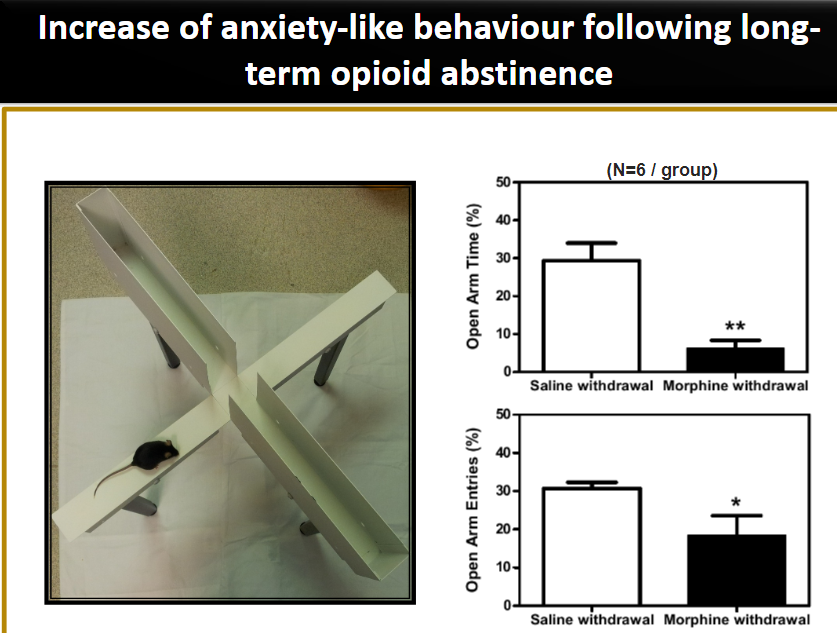
Anxiety-like behaviour: Refers to behaviours that resemble anxiety symptoms, such as restlessness, excessive worry, or hypervigilance, often seen in preclinical models (e.g., animals) after a period of opioid abstinence.
Long-term opioid abstinence: After discontinuing opioid use for a prolonged period, individuals may experience an increase in anxiety-like behaviours due to neurobiological changes in the brain’s reward and stress systems, including dysregulation in neurotransmitter systems like serotonin and dopamine.
-
What is the increase in depressive-like behaviour following long-term opioid abstinence? (2)
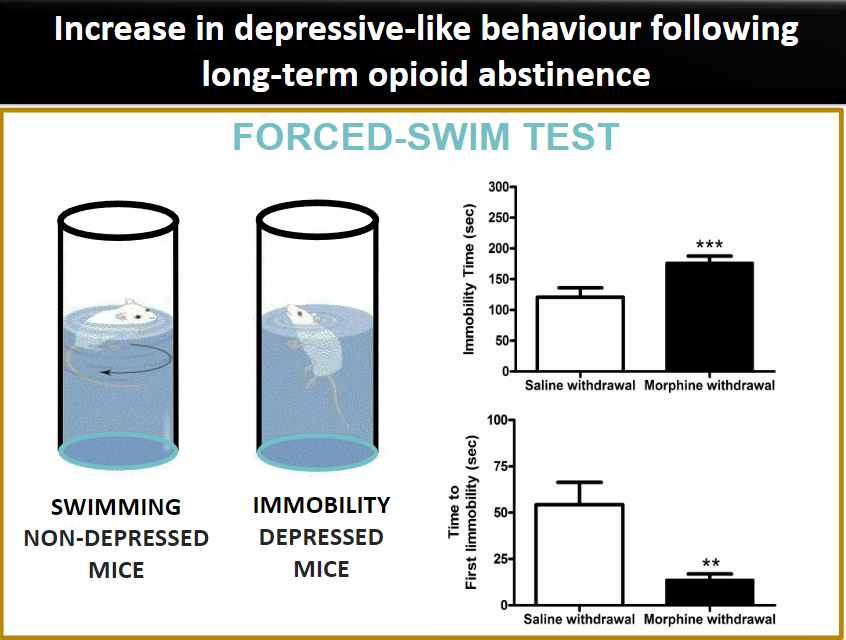
Depressive-like behavior: Refers to behaviors observed in animals or humans that mimic symptoms of depression, such as decreased activity, withdrawal, or lack of motivation, often seen following long-term opioid abstinence.
Long-term opioid abstinence: After prolonged cessation of opioid use, individuals may experience symptoms akin to depression due to changes in brain chemistry, including alterations in neurotransmitter systems (e.g., serotonin, dopamine, and norepinephrine) that regulate mood and reward.
-
What is the Forced-Swim Test? (2)
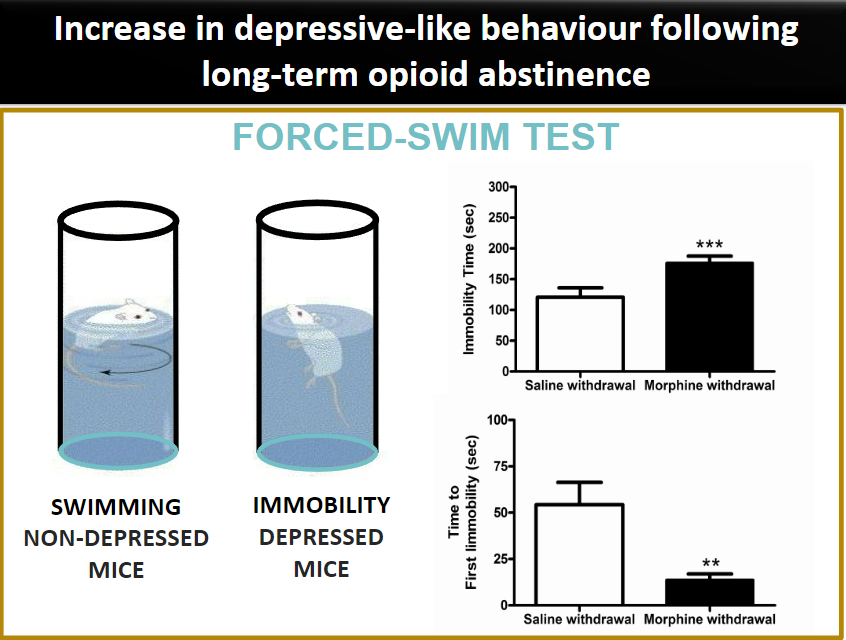
Forced-Swim Test: A behavioural test used in animals to assess depressive-like behaviour. It involves placing an animal in a container of water, where the animal is forced to swim.
Purpose: The animal's behaviour during the test (e.g., the amount of time spent swimming versus immobile) is measured to evaluate the level of despair or hopelessness, which can be indicative of depression-like states. Increased immobility is often used as a measure of depressive-like behaviour.
-
What is the effect of long-term morphine abstinence on social preference? (2)
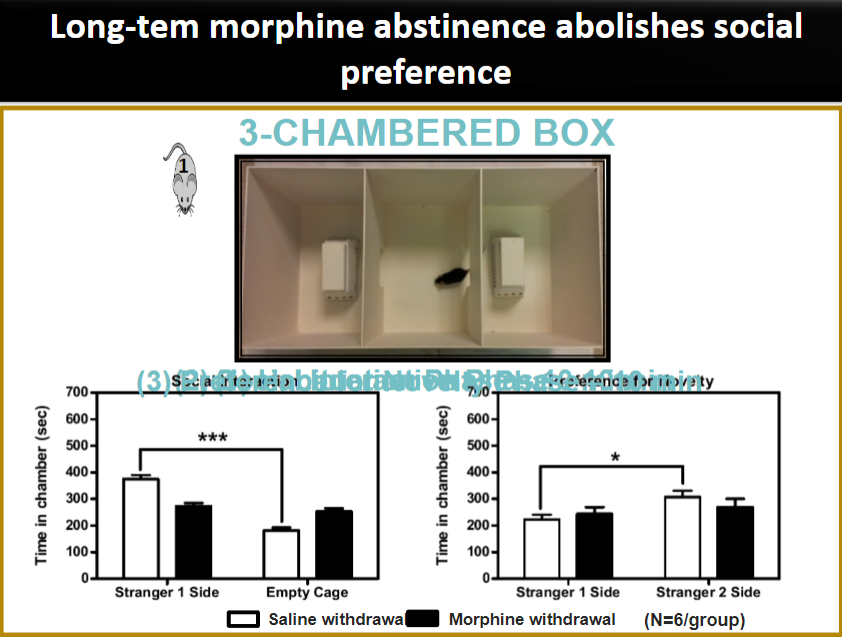
Social preference: Refers to the tendency to engage with social stimuli or individuals, often assessed in animal models.
Long-term morphine abstinence: After prolonged cessation of morphine use, animals may show a reduction or elimination of social preference, indicating withdrawal-related changes in social behavior, possibly due to alterations in the brain’s reward and motivation systems.
-
What is the 3-Chambered Box Test used to assess? (5)
Purpose: A test used to evaluate social preference and social behavior in animals.
Habituation Phase: Animals are given 10 minutes to explore the environment and become familiar with the box.
Social Interaction Phase: The animal is allowed to interact with another animal (e.g., a conspecific) for 10 minutes to measure social preference.
Preference for Novelty Phase: The animal is given the option to explore a novel object or a previously encountered object for 10 minutes, allowing the assessment of novelty preference.
Use in Morphine Withdrawal: In morphine withdrawal studies, the test can show how social preference is affected after opioid abstinence, with morphine withdrawal typically leading to reduced social interaction compared to saline withdrawal controls.
-
What are examples of emotions? (9)
Love
Hate
Disgust
Joy
Shame
Envy
Guilt
Fear
Anxiety
-
What defines emotion? (3)
Emotion refers to complex psychological and physiological responses to stimuli that influence behavior, thoughts, and physical states.
Emotions involve both experiential (subjective) components (how we feel) and physiological (bodily) components (heart rate, sweating, etc.).
Emotions often lead to behavioral expressions (facial expressions, gestures, etc.).
-
What is the James-Lange theory of emotion? (2)
The James-Lange theory proposes that emotions are the result of physiological changes in the body.
For example: We feel fear because our heart races, and we interpret this bodily change as fear.
Process:
Stimulus → Bodily response → Emotional experience (e.g., we feel fear after we notice a rapid heart rate).
-
What is the Cannon-Bard theory of emotion? (3)
The Cannon-Bard theory suggests that emotions and emotional expressions occur simultaneously and independently.
Unlike the James-Lange theory, it proposes that emotions are not caused by bodily responses but are experienced simultaneously as a result of stimuli.
Process:
Stimulus → Simultaneous emotional experience and physiological response.
Dissociation: Emotional experience can happen without physiological expression (e.g., feeling anxious without a noticeable change in body function).
-
How does the thalamus contribute to emotion? (5)
The thalamus is a central relay station in the brain for sensory information.
According to the Cannon-Bard theory, emotions are produced when sensory signals reach the thalamus, either:
Directly from sensory receptors (e.g., sight or sound) or
Indirectly from descending cortical input (thoughts and memories).
The thalamus then sends signals to other brain regions (e.g., the amygdala) for emotional processing.
-
What are the main differences between the James-Lange theory and the Cannon-Bard theory of emotion? (4)
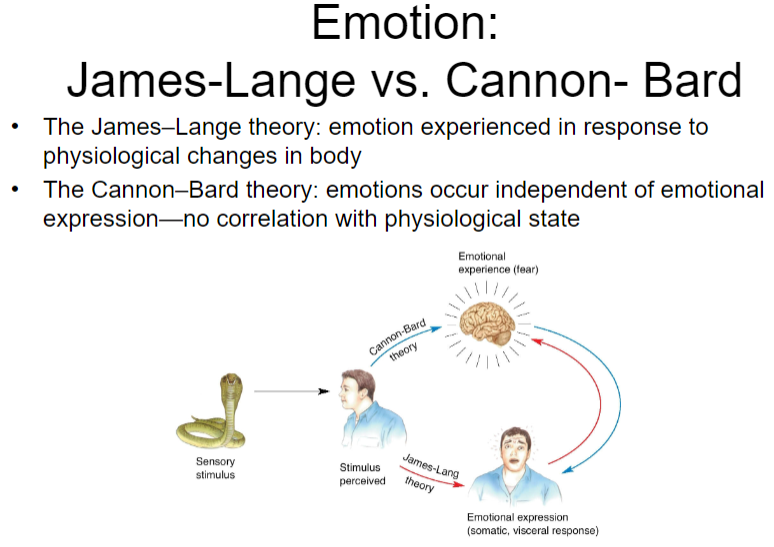
James-Lange theory:
Emotion is experienced in response to physiological changes in the body.
Example: We feel fear because our body experiences physiological changes like a rapid heartbeat.
Cannon-Bard theory:
Emotions occur independently of emotional expression, meaning that emotional experience is not directly tied to physiological changes.
Example: You can experience fear even without a noticeable change in bodily functions (e.g., a racing heart).
-
Is there a brain system responsible for emotions? (4)
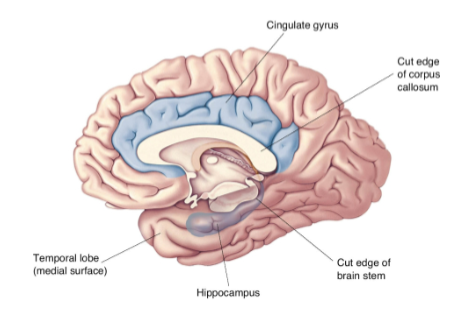
Broca’s Limbic Lobe:
Limbus (Latin) means "border," referring to the primitive cortical gyri that form a ring around the brainstem.
Includes:
The parahippocampal gyrus
The cingulate gyrus
The subcallosal gyrus
-
What is the Limbic System? (3)
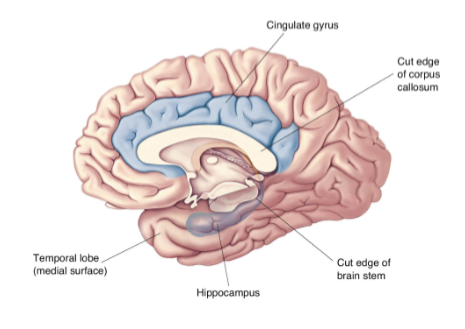
Broca’s Limbic Lobe:
Areas of the brain forming a ring around the corpus callosum.
Includes:
Cingulate gyrus
Medial surface of the temporal lobe
Hippocampus
-
What is the Papez Circuit? (2)
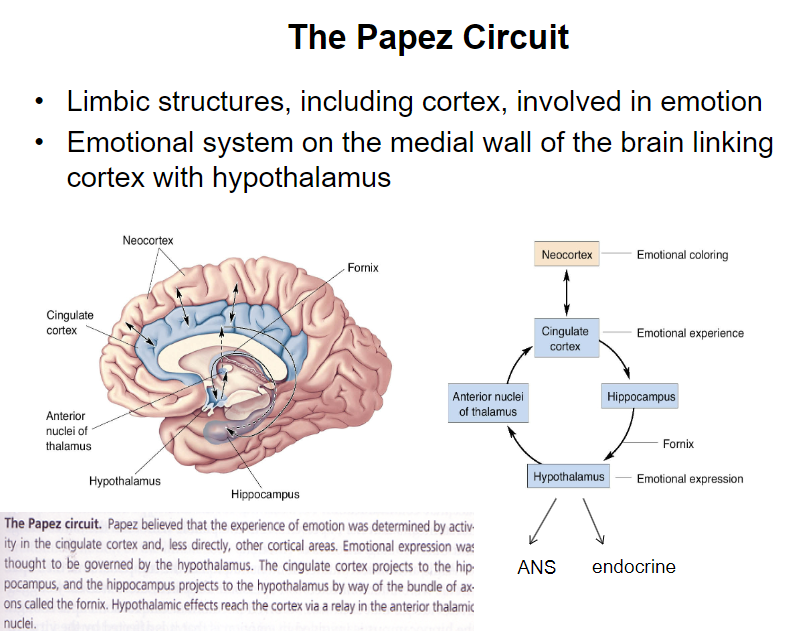
Limbic structures: Involved in emotion, including areas of the cortex.
Emotional system: Located on the medial wall of the brain, linking the cortex with the hypothalamus.
-
What is the Papez Circuit and its components? (4)
The Papez circuit links the cortex with the hypothalamus, involving limbic structures in emotion processing.
The cortex is critical for emotional experience.
The hippocampus governs the behavioral expression of emotion, as shown in rabies infection cases leading to hyperemotional responses.
The anterior thalamus, when damaged, leads to spontaneous laughing or crying.
-
What are the functions of the limbic system? (5)
The limbic system attaches behavioral significance and responses to stimuli, particularly related to emotional content.
Damage to the limbic system leads to profound effects on emotional responsiveness.
The cingulate gyrus plays a role in complex motor control, pain perception, and social interactions, influencing mood.
The hippocampus and parahippocampal areas are primarily involved in memory, connecting sensations and emotions to these memories.
The amygdala is involved in learning and storing emotional aspects of experiences.
-
What are the challenges with the single emotion system concept? (3)
The diversity of emotions and brain activity makes it difficult to pinpoint a single emotion system.
Many structures are involved in emotion, with no clear one-to-one relationship between structure and function.
The limbic system's use as a discrete emotion system is questionable due to this complexity.
-
What are the early and recent theories of emotion? (3)
Early theories of emotion and the limbic system were based on introspection and inference from brain injury and disease.
Studies of disease and brain lesions are not ideal for revealing normal emotional function.
More recent theories include basic emotion theories and dimensional emotion theories.
-
Picture demonstrating Basic theory of emotions:Associated with distinct patterns of brain activity:
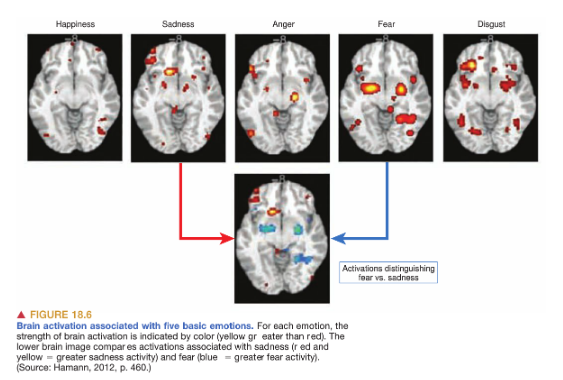
-
What is the amygdala and what is its role in emotion? (3)
The word "amygdala" comes from the Greek word for "almond."
It is a critical structure for emotion, particularly in the regulation of fear and aggression.
The amygdala is also involved in anxiety responses.
-
Picture demonstrating Amygdala and Emotion:
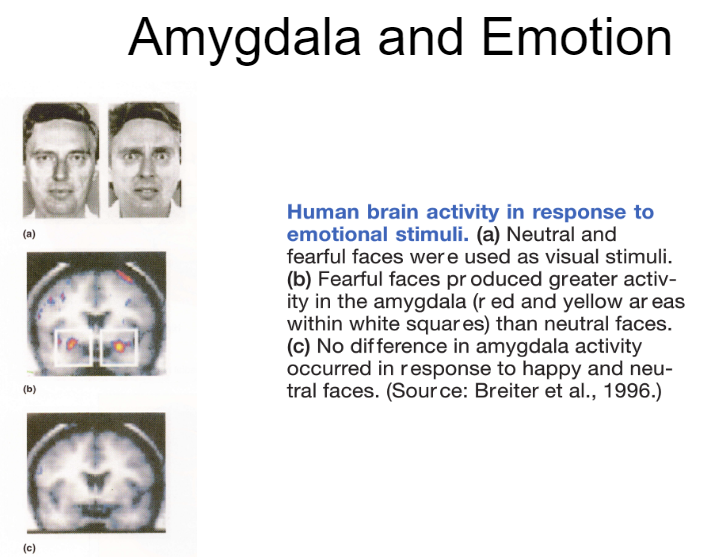
-
Picture demonstrating Amygdala: overview:
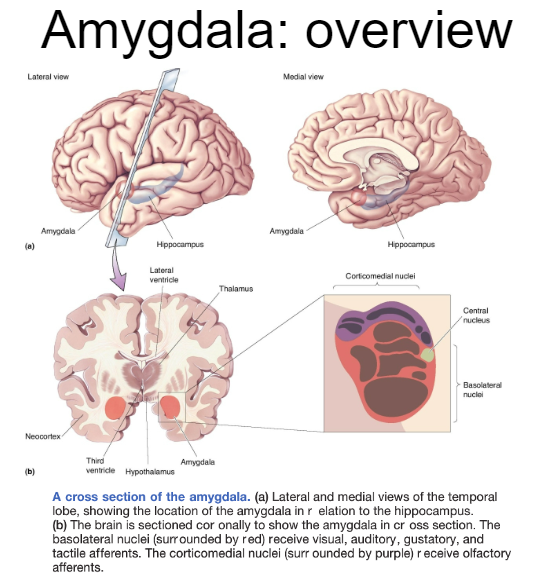
-
Picture demonstrating Amygdala: detail:
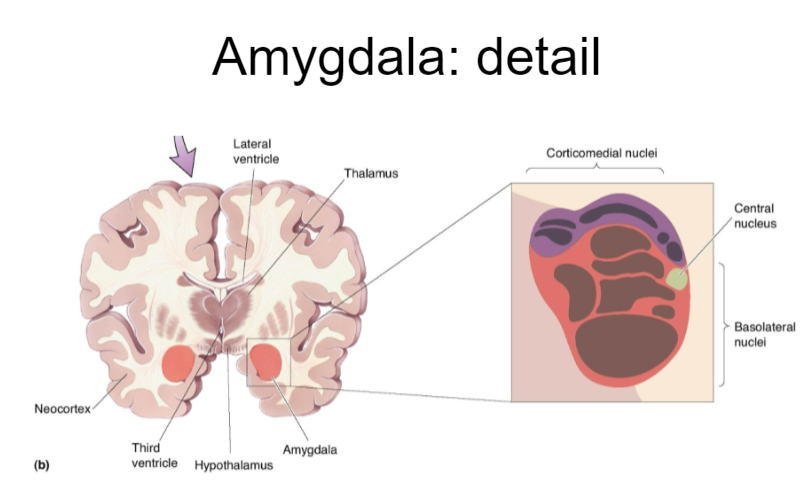
-
What is the structure and connections of the amygdala? (4)
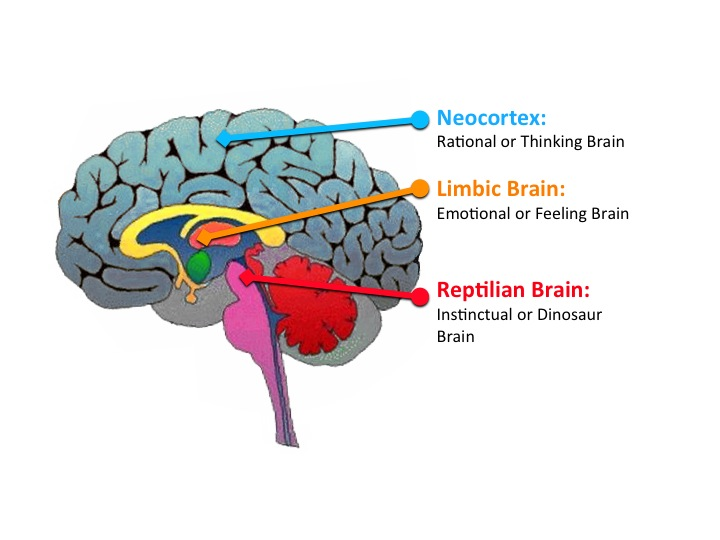
The amygdala receives input from the neocortex, including all lobes, hippocampal, and cingulate gyri.
The basolateral nuclei of the amygdala receive information from all sensory systems.
The corticomedial and central nuclei are involved in processing emotional information.
The amygdala has output to the hypothalamus, a region involved in the expression of emotion, through the stria terminalis and ventral amygdalofugal pathway.
-
What are the effects of amygdala damage and stimulation on fear and behavior? (6)
Kluver-Bucy syndrome (in rhesus monkeys):
Temporal lobe removal (including amygdala, hippocampus) leads to poor visual recognition, psychic blindness, emotional changes (reduced fear), and altered sexual behavior.
Amygdalectomy (in humans):
Reduces fear and aggression.
Leads to hypersexuality and oral tendencies.
Reduces the ability to recognize fearful expressions, but happiness can still be recognized.
Causes flattened emotions.
Electrical stimulation:
Increases vigilance, anxiety, fear, and aggression.
-
What role does the amygdala play in learned fear? (2)
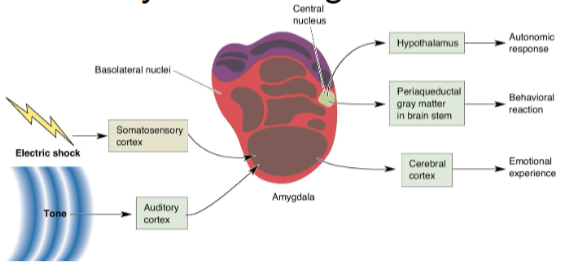
The amygdala is involved in forming memories of emotional and painful events.
This has been confirmed by fMRI and PET imaging.
-
What is the role of the amygdala in the integration of current stimuli and past experience, specifically in learned fear? (2)
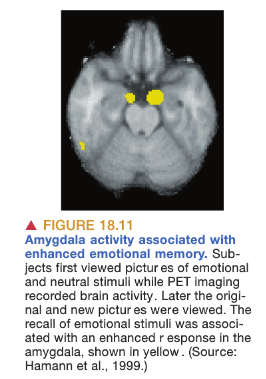
The amygdala gives emotional content to memories, particularly in fear conditioning.
It is involved in conditions such as PTSD.
-
What are the two types of aggression and their characteristics? (5)
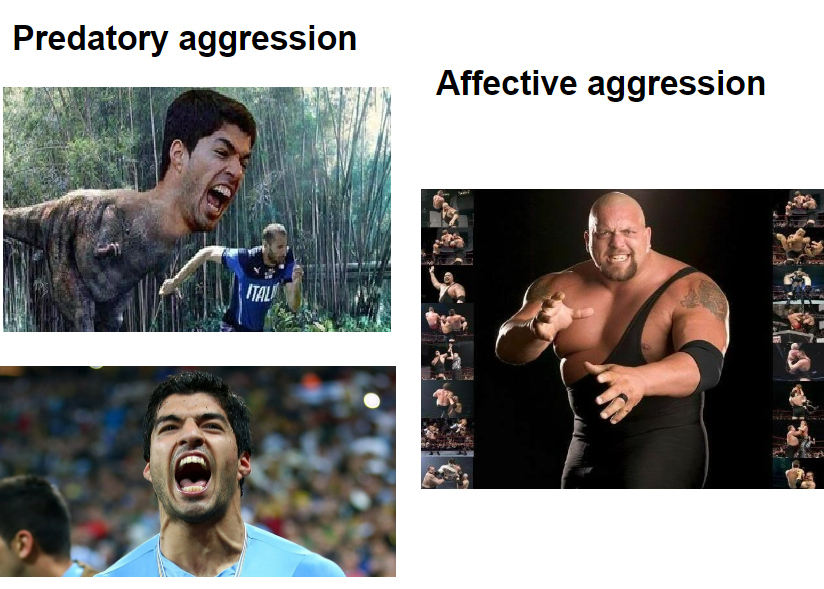
Predatory aggression:
Attacks made against a member of a different species to obtain food.
No sympathetic activity is involved in this form of aggression.
Affective aggression:
Aggression used for show, such as threatening posture, or to assert dominance within a social hierarchy.
High levels of sympathetic activity are involved.
This type of aggression is related to social hierarchies.
-
What is the effect of amygdalectomy and psychosurgery on aggression in humans? (5)
Amygdalectomy and psychosurgery are used to reduce human aggression.
Psychosurgery is now considered a treatment of last resort.
Results of amygdalectomy:
Reduced aggressive behavior.
Relief from anxiety.
Profound, unpleasant side effects.
-
What did Karl Pribram's research on amygdala removal show in rhesus monkeys and humans? (2)
Amygdala removal caused a transformation from dominant to subordinate behavior.
Social hierarchy was affected, with reduced aggression.
-
What are the neural components of anger and aggression beyond the amygdala? (4)
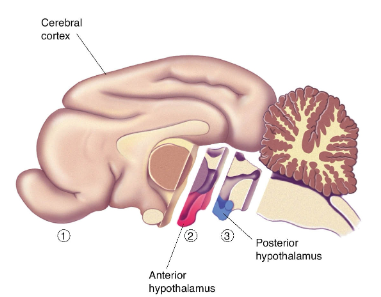
Hypothalamus and aggression:
Removal of cerebral hemispheres (cats) but not hypothalamus -> leads to sham rage.
Removal of both cerebral hemispheres and anterior hypothalamus -> results in sham rage.
Removal of posterior hypothalamus -> no sham rage.
Electrical stimulation of hypothalamus -> leads to affective and predatory aggression.
-
How does the hypothalamus contribute to aggression according to Flynn’s research? (2)
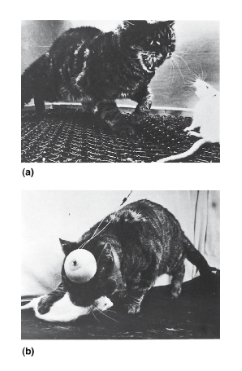
Medial hypothalamus stimulation: Elicits affective aggression.
Lateral hypothalamus stimulation: Elicits predatory aggression.
-
What are the two hypothalamic pathways to the brain stem involved in aggression? (2)
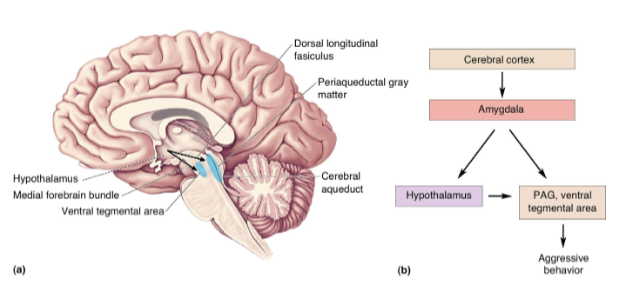
Medial forebrain bundle: Leads to the ventral tegmental area, associated with predatory aggression.
Dorsal longitudinal fasciculus: Leads to the periaqueductal gray matter, associated with affective aggression.
-
What is the serotonin deficiency hypothesis and how is it related to aggression? (4)
The serotonin deficiency hypothesis suggests that aggression is inversely related to serotonergic activity.
5HT antagonists increase aggression.
Agonists of 5HT1A or 5HT1B decrease anxiety and aggressiveness.
In humans, there are reports of a negative correlation between serotonin activity and aggression.
-
What is Affective Neuroscience? (1)
Affective Neuroscience is the science of investigating the neural basis of emotion and mood.
-
What does the James-Lange theory propose about emotions? (1)
The James-Lange theory suggests that we experience emotion in response to physiological changes in our body.
-
What does the Cannon-Bard theory propose about emotions? (1)
The Cannon-Bard theory proposes that emotional experience can occur independently of emotional expression.
-
What is the limbic system and what role does it play in emotion? (2)
The limbic system is a group of subcortical structures of the brain, such as the hypothalamus, hippocampus, and amygdala, that are involved in emotion and motivation.
The amygdala is considered the "emotion center" of the brain, while the hippocampus is crucial in the formation of new memories about past experiences.
-
What is Klüver-Bucy syndrome and what are its symptoms? (2)
Klüver-Bucy syndrome is a condition resulting from bilateral lesions of the medial temporal lobe, including the amygdaloid nucleus.
Symptoms include compulsive eating, hypersexuality, hyperorality (inserting inappropriate objects in the mouth), visual agnosia, and docility.

